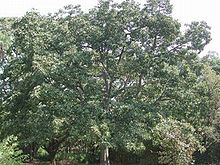Terminalia bellirica
| Terminalia bellirica | |
|---|---|
 |
|
| Scientific classification | |
| Kingdom: | Plantae |
| (unranked): | Angiosperms |
| (unranked): | Eudicots |
| (unranked): | Rosids |
| Order: | Myrtales |
| Family: | Combretaceae |
| Genus: | Terminalia |
| Species: | T. bellirica |
| Binomial name | |
|
Terminalia bellirica (Gaertn.) Roxb. |
|
Terminalia bellirica, known as "Bahera" or Beleric or bastard myrobalan, (Arabic: beliledjبليلج, Sanskrit: Vibhitaka विभितक, Aksha अक्ष ), is a large deciduous tree common on plains and lower hills in Southeast Asia, where it is also grown as an avenue tree. The basionym is Myrobalanus bellirica Gaertn. (Fruct. Sem. Pl. 2: 90, t. 97. 1791). William Roxburgh transferred M. bellirica to Terminalia as "T. bellerica (Gaertn.) Roxb.". This spelling error is now widely used, causing confusion. The correct name is Terminalia bellirica (Gaertn.) Roxb.
The leaves are about 15 cm long and crowded toward the ends of the branches. It is considered a good fodder for cattle. Terminalia bellirica seeds have an oil content of 40%, whose fatty-acid methyl ester meets all of the major biodiesel requirements in the USA (ASTM D 6751-02, ASTM PS 121-99), Germany (DIN V 51606) and European Union (EN 14214). The seeds are called bedda nuts.
In traditional Indian Ayurvedic medicine, Beleric is known as "Bibhitaki" (Marathi: " Behada or Bhenda ") (Terminalia bellirica). In its fruit form, it is used in the popular Indian herbal rasayana treatment triphala. In Sanskrit it is called vibhīdaka विभीदक.
According to Dymock, Warden, Hooper: Pharmacographia Indica 1890 :
"This tree, in Sanskrit Vibhita and Vibhitaka (fearless), is avoided by the Hindus of Northern India, who will not sit in its shade, as it is supposed to be inhabited by demons. Two varieties of T. belerica are found in India, one with nearly globular fruit, 1/2 to 3/4 inch in diameter, the other with ovate and much larger fruit. The pulp of the fruit (Beleric myrobalan) is considered by Hindu physicians to be astringent and laxative, and is prescribed with salt and long pepper in affections of the throat and chest. As a constituent of the triphala (three fruits), i.e., emblic, beleric and chebulic myrobalans, it is employed in a great number of diseases, and the kernel is sometimes used as an external application to inflamed parts. On account of its medicinal properties the tree bears the Sanskrit synonym of Anila-ghnaka, or "wind-killing." According to the Nighantus the kernels are narcotic."
...
Wikipedia
